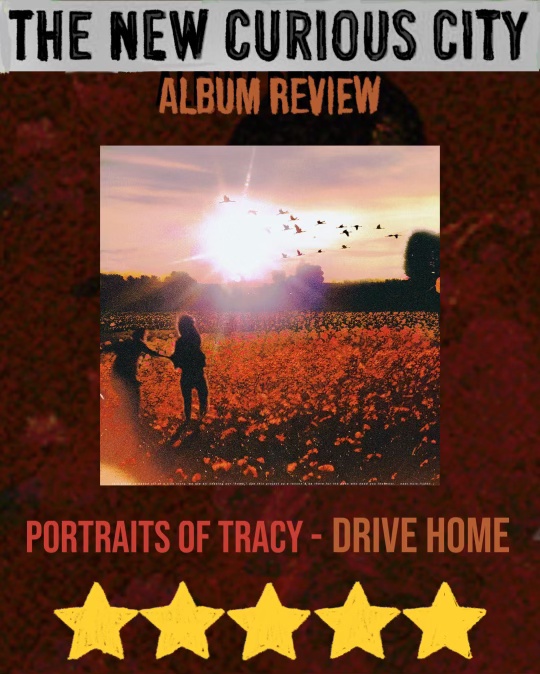Tracklist
Lost!
8 Minutes
Aeternum
En Garde
The Party
Drunk*
The Afterparty
Parking Lot
Home
W. McKinley
Ten Years
Someday
Signals
Forbidden Fruit
…
Found!
… (Continued)
Graceland

Over the course of four years, Portraits of Tracy crafted one of 2023’s most well-executed and emotionally refined music releases: Drive Home. The moniker Portraits of Tracy is coupled with an impressive biography. Portraits of Tracy is the project by (now) 19-year-old Tracy Amare from Baton Rouge, Louisiana who began publishing hip-hop beat remakes and self-produced works on platforms like SoundCloud and YouTube at 15 years old. You see, Drive Home is an extensive project by such a young, self-taught producer and multifaceted musician who created its intricate musical landscape. The songs that compose this landscape cover elements of jazz, hip-hop, electronica, soul, and folk–but they are always interwoven with a fresh, “genreless” sonic foundation that is perfectly molded for Portraits of Tracy’s musical worldbuilding. Tracy’s knack for musical worldbuilding shines throughout Drive Home as each song reflects on a raw, human narrative through its main character, Junie.
Between the primarily musical tracks, there are several tracks that serve as dialogue-based, narrative interludes. The three-minute opening track “Lost!” feels like a portal entrance into the album’s landscape with a celestial buildup involving the xylophone, which gradually welcomes the heaviness of electric guitar and Tracy’s powered vocals. “Lost!” smoothly transitions into the first narrative interlude, “8 Minutes,” the album’s introduction to Junie, a young artist longing for rest before his performance set in 8 minutes. It is worth noting that besides the voice actors in interludes like “8 Minutes,” each track is executively produced by Portraits of Tracy. The following track “Aeternum” is a perfect showcase of her smile-inducing talents, complete with addictive beat switches, poppy vocal chops from The Whatnauts’ 1971 track “My Thing,” string sections, and Tracy rapping in Junie’s perspective about emotional discourse surrounding identity. Although that brief description does not do the narrative justice, there is no doubt that–just three tracks in–listeners witness Drive Home’s tasteful maximalism via heavy production elements over intense lyricism, which contributes to the lingering sense of urgency in the album’s storytelling. “Aeternum” ends with an introduction to Ema, Junie’s roadie and companion throughout the “shitshow” (story).
The theme of identity plays an imperative role throughout the project. Track 4: “En Garde” poses as a profound revelation of identity and pulls us into the harsh emotions consuming Junie in this chapter with a heavier use of percussive elements to complement Tracy’s vocal layers. In July of 2023, Tracy Amare posted via social media about her journey coming out as a transgender woman and expressed gratitude for all of the received online support from the past years. Referring to her past moniker and government name: “that person WAS NOT REAL.” One could only assume the parallels between Tracy and Junie, but one thing is for certain: the theme of identity and acceptance of identity is interwoven throughout Drive Home and Portraits of Tracy’s execution of that theme is masterful.
Leading into dopamine-inducing “The Party,” the role of dialogue and spoken word feel essential to the listening experience of Drive Home. The inferred importance of each track, as one progresses into the next as part of a narrative, further solidifies how well Portraits of Tracy implements musical worldbuilding. From “The Party” to the following track, “Drunk*,” the hypnotic production involving synths and a pulsing bass continues to immerse the listener in Junie’s riveting emotions even without an interlude track. Well, “The Afterparty” clarifies Junie’s experience as an “episode” and exerts the force of such emotions with heartbreaking lyrics like:
I’m stuck in this rabbit hole
I’m falling infinite
Mama I don’t wanna die
But when I do, I know I’m gonna fry
Furthermore, Ema’s role as a friend who truly understands and cares for Junie shines in the next interlude track, “Parking Lot.” The violently dramatic transition into “Home” grasps tightly onto that lingering urgency, as the track perfectly depicts Junie’s tendency to stay away from home as an escape from his old, unauthentic self. The R&B-flowing track “W. McKinley” and interlude “Ten Years” essentially feel like a surrendering trip down memory lane as Junie makes his way back home and meets his mother, Marie, and, after ten years, his friend, Amari. Although the middle of Drive Home is less composed of those whirling production elements heard in opening tracks, the narrative of Junie’s life feels most imperative at this point, creating an intent balance in the album.
Going into Track 12: “Someday,” Portraits of Tracy’s musical ideas seem to dance well with the craft of other artists. The track itself samples Labi Siffre’s 1973 track of the same title (“Someday”), which prompted my recollection of Siffre as an openly gay, black folk artist. Although Portraits of Tracy’s inclusion of Siffre’s music has no direct correlation to the narrative, at the least, I heavily appreciated the beauty of the sonic parallels between the two tracks while listening to “Someday.” Beyond the samples, the image below lists all of the artists that inspired Drive Home. As you can see, the depth of Portraits of Tracy’s insight into music at this point of her young adult life is simply breathtaking.

Following “Someday” and approaching the end of the album, Ema and Junie’s relationship are key to “Signals” and “Forbidden Fruit,” as Junie confesses his love to Ema in front of his family and friends. “Forbidden Fruit” follows a similar production route as the past musical tracks, but the role of lyricism clearly overtakes the importance of production at this point. Nonetheless, the staccato articulation of the synth is tastefully integrated into the track as the album reaches a critical checkpoint. Track 15: “…” once again utilizes a dialogue-based interlude to express that critical checkpoint, as the discourse surrounding Junie’s confession prompts his mother, Marie, to storm off with frustration. The almost-complete worldbuilding of Drive Home at this point has only displayed how the well-executed performances, integrated into the musical landscape itself, make this project a precious addition to 2023.
Reaching the end, “Found!” and “… (Continued)” encapsulate a heart-racing climax to the narrative world that Portraits of Tracy has created. Junie previously poured himself out to Ema and others surrounding them, which freed him from the bottled-up fear that plagued him from the start. Despite the discourse following Junie’s confessions, “Found!” (as opposed to the opening track, “Lost!) takes the listener through a conflicting yet liberating euphoria with the vocal-synth chops over pulsing percussion that keenly imitate heartbeats. The smooth transition into the final interlude track, “… (Continued),” suddenly kills the flame ignited in “Found!” as Junie learns that his mother died in a car accident after angrily leaving the event. The final track, “Graceland,” captures Junie’s reaction and closes that “portal” that once pulled the listener into Drive Home.
“Graceland” is a special song of 2023, or possibly of the entire decade, because it is an outstanding, maximalist, and emotional masterpiece that perfectly closes the substantive, colorful project that is Drive Home. As the lyrics imply, Junie truly leaves everything behind by taking his own life via overdose (“I’ve swallowed all of my pills…
to finally get the feeling of being all alone…”) and the world he knows is slowly fading away. The first three minutes of the track sonically reflect on the chaos filling Junie’s life after receiving news of Marie’s death, then a minute of whirling yet popping piano sounds place the track at a moment of brief resolution until the pulsing, layered production elements return. The buildup of the track’s ending is astonishingly heavenly, as the returning electric guitar, synths, and choir-like vocal performance create an overwhelming sensation that is perfectly juxtaposed with the disintegration of the world we knew in Drive Home. “Graceland” ends the story just as well as the entire album built the story.
To put it simply, Tracy Amare (“Portraits of Tracy”) knows how to tell the perfect story through music and 2023’s Drive Home is a testimony to that. At the current age of 19 years old, she possesses the insight of artists that have decades of musical discography under their belt. This 4-year project offered listeners a glimpse into Tracy’s worldbuilding talents while gradually pulling them into the narrative itself. For that, I am extremely thrilled to see where Portraits of Tracy takes her production and multi-instrumental skills moving into the upcoming years.

Check out Portraits Of Tracy’s masterpiece, ‘Drive Home’ on bandcamp.
You can also stream it on Spotify and Apple Music.







